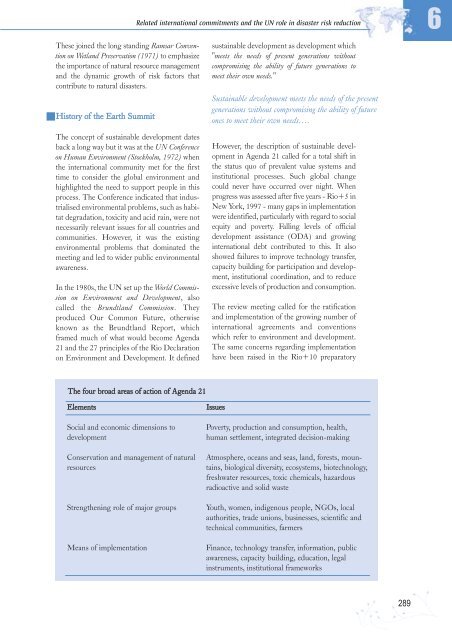A global review of disaster reduction initiatives - Welcome to the ...
A global review of disaster reduction initiatives - Welcome to the ...
A global review of disaster reduction initiatives - Welcome to the ...
Create successful ePaper yourself
Turn your PDF publications into a flip-book with our unique Google optimized e-Paper software.
These joined <strong>the</strong> long standing Ramsar Conventionon Wetland Preservation (1971) <strong>to</strong> emphasize<strong>the</strong> importance <strong>of</strong> natural resource managementand <strong>the</strong> dynamic growth <strong>of</strong> risk fac<strong>to</strong>rs thatcontribute <strong>to</strong> natural <strong>disaster</strong>s.His<strong>to</strong>ry <strong>of</strong> <strong>the</strong> Earth SummitRelated international commitments and <strong>the</strong> UN role in <strong>disaster</strong> risk <strong>reduction</strong>sustainable development as development which"meets <strong>the</strong> needs <strong>of</strong> present generations withoutcompromising <strong>the</strong> ability <strong>of</strong> future generations <strong>to</strong>meet <strong>the</strong>ir own needs."Sustainable development meets <strong>the</strong> needs <strong>of</strong> <strong>the</strong> presentgenerations without compromising <strong>the</strong> ability <strong>of</strong> futureones <strong>to</strong> meet <strong>the</strong>ir own needs….6The concept <strong>of</strong> sustainable development datesback a long way but it was at <strong>the</strong> UN Conferenceon Human Environment (S<strong>to</strong>ckholm, 1972) when<strong>the</strong> international community met for <strong>the</strong> firsttime <strong>to</strong> consider <strong>the</strong> <strong>global</strong> environment andhighlighted <strong>the</strong> need <strong>to</strong> support people in thisprocess. The Conference indicated that industrialisedenvironmental problems, such as habitatdegradation, <strong>to</strong>xicity and acid rain, were notnecessarily relevant issues for all countries andcommunities. However, it was <strong>the</strong> existingenvironmental problems that dominated <strong>the</strong>meeting and led <strong>to</strong> wider public environmentalawareness.In <strong>the</strong> 1980s, <strong>the</strong> UN set up <strong>the</strong> World Commissionon Environment and Development, alsocalled <strong>the</strong> Brundtland Commission. Theyproduced Our Common Future, o<strong>the</strong>rwiseknown as <strong>the</strong> Brundtland Report, whichframed much <strong>of</strong> what would become Agenda21 and <strong>the</strong> 27 principles <strong>of</strong> <strong>the</strong> Rio Declarationon Environment and Development. It definedHowever, <strong>the</strong> description <strong>of</strong> sustainable developmentin Agenda 21 called for a <strong>to</strong>tal shift in<strong>the</strong> status quo <strong>of</strong> prevalent value systems andinstitutional processes. Such <strong>global</strong> changecould never have occurred over night. Whenprogress was assessed after five years - Rio+5 inNew York, 1997 - many gaps in implementationwere identified, particularly with regard <strong>to</strong> socialequity and poverty. Falling levels <strong>of</strong> <strong>of</strong>ficialdevelopment assistance (ODA) and growinginternational debt contributed <strong>to</strong> this. It alsoshowed failures <strong>to</strong> improve technology transfer,capacity building for participation and development,institutional coordination, and <strong>to</strong> reduceexcessive levels <strong>of</strong> production and consumption.The <strong>review</strong> meeting called for <strong>the</strong> ratificationand implementation <strong>of</strong> <strong>the</strong> growing number <strong>of</strong>international agreements and conventionswhich refer <strong>to</strong> environment and development.The same concerns regarding implementationhave been raised in <strong>the</strong> Rio+10 prepara<strong>to</strong>ryThe four broad areas <strong>of</strong> action <strong>of</strong> Agenda 21ElementsSocial and economic dimensions <strong>to</strong>developmentConservation and management <strong>of</strong> naturalresourcesStreng<strong>the</strong>ning role <strong>of</strong> major groupsMeans <strong>of</strong> implementationIssuesPoverty, production and consumption, health,human settlement, integrated decision-makingAtmosphere, oceans and seas, land, forests, mountains,biological diversity, ecosystems, biotechnology,freshwater resources, <strong>to</strong>xic chemicals, hazardousradioactive and solid wasteYouth, women, indigenous people, NGOs, localauthorities, trade unions, businesses, scientific andtechnical communities, farmersFinance, technology transfer, information, publicawareness, capacity building, education, legalinstruments, institutional frameworks289

















